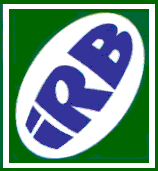 |
||
 |
||

Introduction
Outcome Goals:
Attack -
Defense -
Performance Goals:
Attack -
Defense -
Frequent Errors -
Team Selection -
Conclusion
IRB SEVEN-A-SIDE COACHING MANUAL
If a team defends, only after conceding possession is the effectiveness of
the
defence reduced.
It is the quality of the possession that will initially determine the effectiveness of the attack. By contesting the ball this effectiveness will be reduced, enabling the actions that follow to recover the ball, to be more effective.
By denying space to an attack, the defence gives the attack less time and
space to penetrate.However, in Sevens, the defence must operate as a unit by moving forward together, so that they keep their formation and shape. To retain peripheral vision, players further from the position of the ball must align, so that they can see what is happening with the ball. Equally, they must not get ahead of those inside, as this will create a gap in the defensive line. Players should move up and across together, so that the ball carrier can be tackled from the inside, not the outside. If a defender is directly in front, both sides are available to the ball carrier. See Diagram (7) - Defending directly in front. If the defender is outside the ball carrier, the player will have to move in to make the tackle. While this may be effective, better players will pass to a support player, running to penetrate through the space which the defender has moved away from. See Diagram (8) , (9) , & (10) - Defensive Alignment The basic method of defending is, therefore, 'inside-out, however, better players may develop variations on this. As a unit, the defence must be disciplined to operate to a pattern. This involves a total understanding of the pattern by each team member and confidence by individual players in those around them. This allows the players to focus on their role within the pattern. They will not be distracted by a flaw in a team-mate's defence, from successfully performing their role to select their opponent. To play as a unit, the defence must play to a pattern. The two main patterns are those where the designated attacker is identified by numbering along the backline to select their opponent i.e. man-on-man defence See Diagram (11) - Defending inside-out, and Diagram (12) - Defending outside-in and the second, by defending a zone and being responsible for a ball carrier in that zone. A major advantage of zone defence is that it prevents the defenders from bunching when the attack is lateral. ie: across the field, as they are defending a space, not a player. * See Diagram (13) Defending-Zone defence - In all Sevens defence, the player should position so that both the ball, and the player the defender is most likely to have to tackle, can be seen at the same time. This will require the defender to stand deep enough to do so. Players with better peripheral vision will be able to stand closer to the attack, reducing time and space. With less skill, more depth is required and more time and space will be conceded to the advantage of the attack. In the section on Performance goals, each defence pattern will be explained. Included in this explanation will be the patterns necessary to defend the space behind the first line of defence, when either the ball is behind or the first line of defence is penetrated.
Effective tackles are made inside out, giving the ball carrier only one
side of the
tackler, to attempt to penetrate on the outside.While a low tackle may stop the ball carrier, a pass can be made to an attacking player as the arms are free. This is aggravated if the pass is made to a player running inside the ball carrier, as the tackler will have been taken out of the space the pass is made into.
Unless it is a head-on tackle, this will always be the case, as the tackler will have to move out of space to make a side-on tackle. If support is not available and the pass is not made, the ball will become contestable, as it will have to be played immediately the tackle has been completed. However, it may be better defence to use a smother tackle to prevent the pass being made in the first place. This may involve more than one defender. So that an advantage is not conceded, if possession is not regained, defenders must form a maul and rely on the'use it or lose it' Law to obtain the throw in at the scrum. Often to complete a tackle more than one player is required. Sound judgement is necessary for this to occur in Sevens, because, if too many players become involved in the tackle and the ball is not regained, there will be gaps in the defence pattern.
Possession can be regained during the tackle as mentioned under 'Tackling
the
ball carrier'.However, possession can be regained in other circumstances. Obviously, recovering the ball after it has been kicked, is the responsibility of the player defending the space behind the defence. The skills required to do this are catching the high ball and picking up the ball off the ground. However, because retention of possession is of such high priority in Sevens, most opportunities come from loose ball. This occurs when the ball is placed after a tackle and when errors are made in passing and receiving a pass, usually because of defensive pressure. In Sevens, offside Laws are far less effective because so much of the play is general play. General play is play not initially based on a source of possession, from which offside lines exist for the defending team. These sources of possession are the scrum, ruck and maul, in which an offside line exists through the hindmost foot of players in the formation. Players who are not involved in the contest for possession are offside, if they are in front of this line before the ball leaves the formation. The same applies to lineouts. However, from lineouts the line is lo metres from the centre line down of the lineout. Once the ball leaves the sources at possession there are no offside lines for the defence. Consequently the defending team may position anywhere until another formation is formed, after which the restriction once again applies. The IRB Experimental Law Variation preventing a defender from entering play from their opponents side of the ball, will have important implications for the attacking team. In Sevens, players wish to retain possession even if this means conceding territory. To prevent turnovers, the ball will not be kicked out of play unless the situation is desperate and contact will be avoided if possible, reducing the likelihood of turnovers. In general play, restrictions exist for attacking players, who may not enter play from a position ahead of the last player in their team, who has played the ball. For the defence, play can be entered into from only the defending team's side of the ball. This means that when a tackle is made, the defending player can attempt to recover the ball from a position in front of the ball carrier. Retreating defenders will not be able to enter play, without first passing the line of the ball within close proximity of the tackle. This means that when a tackle is made and the ball is rolled or placed towards the tackled players team mates, the retreating defender cannot recover the ball if it is within one metre of the tackle. This will alter opportunities for the defence to regain possession.
|
Copyright 1999-2025
